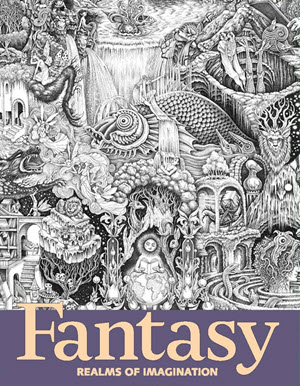Fantasy at the British Library
 The British Library recently opened a major new exhibition titled, Fantasy: Realms of Imagination. If you can get to London, it is well worth a look. As I was in town anyway for Judith Clute’s book launch, I popped in to take a look.
The British Library recently opened a major new exhibition titled, Fantasy: Realms of Imagination. If you can get to London, it is well worth a look. As I was in town anyway for Judith Clute’s book launch, I popped in to take a look.
The thing that stands out about the exhibition is that it does things that only the British Library can do. It has the original copy of Beowulf (there is only one in existence). It has a 14th Century copy of The Iliad. It has a copy of Sir Gawain and the Green Knight, complete with an illustration showing the knight wandering around with his head in his hands. It has Charles Dodgson’s original draft of the book he was going to call Alice’s Adventures in the Underground. It has Ursula K Le Guin’s original notes for A Wizard of Earthsea. That’s just ridiculous.
However, the exhibition is by no means focused on the past. There are plenty of contemporary works there too. And interviews with contemporary authors. A reasonable attempt has been made to include works from a wide variety of cultures.
The exhibition has also avoided focusing on written literature. Comics, films and TV, and video games all have their place. So too do Dungeons & Dragons, Warhammer and Magic the Gathering. Middle Earth and Westeros as represented as much by Gandalf’s staff, and Arya Stark’s sword, Needle, as they are by books.
An exhibition can make points simply through what is chooses to include or exclude, but it can also do so through text. The label for Percy Shelley’s poem, Queen Mab, explains that Shelley used the poem as a vehicle for promoting his radical, utopian politics. Thus the idea that putting politics in fantasy is somehow a very modern thing is neatly punctured.
My Finnish readers will be happy that Tove Jansson makes an appearance in the exhibition. While the label acknowledges her creation of the Moomins, she’s mainly there because of her illustrations for the Swedish edition of The Hobbit. Tolkien was apparently sufficiently annoyed by her depiction of Gollum to actually amend the text in future editions to make his vision for the character clear.
Oh, and Irma, they have one of Mervyn Peake’s notebooks showing a rather fine drawing of the Prunesquallors.
One of the more surprising items on display is a Hugo Award trophy. It is not one for a famous book. It is Jeanette Ng’s Related Work Hugo, which she won for her speech in Helsinki when she won what was then called the Campbell Award for Best New Writer. The point is to show that fantasy can and does change when it needs to.
If there is one thing that I thought might be under-represented in the exhibition it is contemporary fantasy, in particular paranormal romance which is a huge part of the genre. The modern fashion for mythological fantasy was also missing, though of course they did have The Iliad. However, you can’t include everything, and given how hard the curators worked to be inclusive I think they can be forgiven for not being perfect.
If you can’t get to London, there are satellite exhibitions being staged at a number of city libraries around the country. I saw the one in Bristol when I was invited to give a talk there as part of the support program. I’m not sure which libraries have exhibitions, but it is worth checking your local establishments. Obviously they won’t have the spectacular items that are in London, but it would be good to support them if you can.
My talk in Bristol has been turned into an essay, and I’ve just signed a contract for it to be published elsewhere next year.
If you want a flavour of the online events, the one with Neil Gaiman and Roz Kaveney is available in full via the Living Knowledge Network. It is well worth a listen. They both have interesting things to say. They encourage everyone to read John M Ford. And I’m particularly pleased that they got to talk about A Game of You. I can defend Neil until I’m blue in the face, but it is unlikely that any of the Angry Online Trans People will believe me. They might listen to Roz.